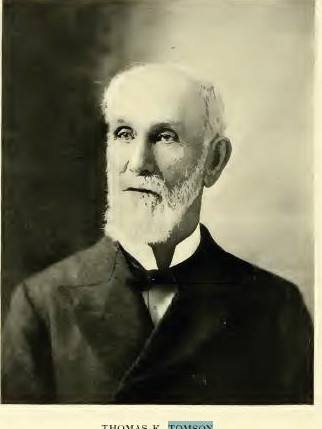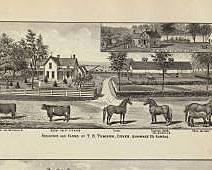Maple Hill Township was formed from Newbury Township in 1872 and there after, Independence Day or the Fourth of July was an important time to remember the American Revolution. There were many people living in 1872, that could trace their heritage to one of the brave soldiers that fought against the British at Lexington, Concord, Valley Forge, Trenton and many other battle sites. The pioneer settlers, as are we, were very proud and patriotic.
In 1877, Maple Hill News Items in the Alma newspaper mention: “An Old-Fashioned July Fourth Celebration will be held in Tomson’s Grove.”
On July 11, the same news items reported: “The Celebration at Maple Hill was without a doubt one of the most eloquent. Except for one incident, when Capt. R. J. Stephenson’s son was struck by lightening and killed the day before, all went well. Dr. T. N. Watts gave a beautiful andd moving oration and new celebration officers were elected for next year.”
In 1883, it was reported in the Maple Hill News Items that “Rev. W. S. Crouch, pastor of the Eliot Congregational Church, delivered the oration for the July 4th Celebration.”
Just two years later, this article appeared in Alma Newspapers: “The people of Maple Hill, are planning one of the grandest Fourth of July Celebrations ever held in Wabaunsee County. Horse, mule, Jennet and foot racing, glass ball, pigeon and rifle matches, rope pulling, wrestling, lawn tennis, brass band, evening dancing, and much more! Everyone come!”
Now some of us may need a little translation of the terms that are used in this last article. Do you know what a jennet or jenny is? Both are female mules. Jennet was a term used used first in Ireland and brought to America by Irish immigrants. Jenny was the more common term used in the Midwest. The fact that the writer used jennet probably indicates some Irish ancestry.
In those days, all shooting sports were popular but one that required great skill was breaking a glass ball with a rifle shot. Remember, most guns in those days still used black powder and lead shot so breaking a glass ball was no easy feat. The “pigeons” referred to were round clay disks called “pigeons” or “clay pigeons.”
I want to talk about two of the people mentioned in the newspaper clippings. They are: Thomas K. Tomson and Richard John Stephenson.
Both were early pioneers in Maple Hill Township. I have biographies for both. Tomson’s biography came from the 1902 Wabaunsee County Atlas, and I was able to find Stephenson’s obituary in the Rawlins County (Kansas) Republican.
Here is the Tomson article. THOMAS K. TOMSON.
“Thomas K. Tomson, whose portrait is herewith shown, is extensively engaged in raising cattle and in general farming operations in Dover township, Shawnee County. He has been a resident of this county for many years and is prominently known among its citizens. He was born at Youngstown, Ohio, in 1826, and is a son of Cornelius and Anna (Kyle) Tomson, and grandson of Leffard Tomson, who was a native of Pennsylvania. Our subject’s mother was a daughter of Joshua and Mary (Stewart) Kyle, her father a native of Ireland and her mother, born on a ship in mid-ocean.
Thomas K. Tomson received his educational training in the public schools of Youngstown, Ohio, and in the spring of 1856 made a trip through the Western country. Upon his return to Ohio he was married, in 1857, and shortly after went with his wife to Lee County, Iowa, where he lived on a farm near Fort Madison for two years. He then purchased land near Carthage, in Jasper County, Missouri, but never settled upon it. In 1861 he came to Topeka, Kansas, and the following year took up a quarter-section of land in Wabaunsee County, on which he lived four years. He then sold out and bought and improved a farm four and a half miles east of this farm, living upon it four years. He purchased a farm in Mission township, four and a half miles west of Topeka, and after one year moved to the city, where he purchased a livery and other properties, a portion of which he still owns. In the meantime he engaged extensively in dealing in cattle in partnership with his two sons, John R. and James G., leaving his livery in charge of his partner, who first was a Mr. Dilley and later J. B. Love, who now conducts the establishment. In 1881 Mr. Tomson purchased his present farm of 212 acres, situated in section 35, township 12, range 13, and section 2, township 13, range 13. in Dover township, and all told has some 575 acres. He is a progressive business man of unusual ability, and has attained a high degree of success.
Mr. Tomson was married in 1857 to Elizabeth C. Davis, a native of Ohio, who died in 1878, leaving five children: Anna Bell, now deceased; Ella, who married John N. Riley, a farmer and stock-raiser living near Cottonwood Falls, Kansas, and has three children, Fred Belle and William; John R., who married Carrie Loomis, a daughter of Harry J. Loomis, who located in Wabaunsee County in 1856 and still lives there. they have one child. Marjorie Bell; Frank D., who has a position, at Cedar Rapids, Iowa, paying a salary of $4,000 a year, he married Tina Coburn, a daughter of Foster D. Coburn. of Topeka. secretary of the State Board of Agriculture,
and has two children, Gertrude and Helen; and James G., engaged in the stock-raising business with his father and brother, who married Jean Edna Beach and hves with his father. Mr. Tomson and his sons make a specialty of Shorthorns, and usually have on hand about 130 head.
Thomas K. Tomson formed a second marital union with Mrs. McArthur, a daughter of Joseph Miller, one of the pioneers of Topeka. She was seven years old when she accompanied her parents to this city and here she resided until her death in 1899. This union resulted in the birth of a son, Joseph M., who is attending Topeka Business College. Fraternally, Mr. Tomson and his son, James G., are Odd Fellows, and his sons, John R., and Frank D., are Masons. Politically, all are stanch Republicans. In religious attach- ments they belong to the Congregational Church.”
This is a copy of Stephenson’s obituary: Obituary-Republican Citizen, Rawlins,Kansas,1-8-1898
“Richard John Stephenson was born in Westmoreland, Buckinghamshire, England, November 11, 1822, and died at Blakeman, Kansas, of hemorrhage of the stomach, December 28,1897, aged 74 years, 1 month and 17 days.
Early in life, Captain Stephenson became a sailor, commencing his seafaring life when a lad of ten years. In his thirteenth year he was engaged in the merchant marine of his native country, sailing between English and Mediterranean ports. When twenty years old he came to the United States, settling at Providence Rhode Island, where he remained in the seafaring life he had adopted, being engaged in whaling and the general maritime trade, sailing much in every part of the Pacific Ocean. His was a toilsome life then, but at times full of excitement and danger. To the grave he carried the scars of some wounds inflicted by savage spears in South Pacific waters. In May, 1855, Captain Stephenson removed to Medina County, Ohio, where he engaged in farming and the sheep industry, devoting much of his time in the summer and during the time navigation was open to the carrying trade on the lakes. During his residence in Ohio he was married at Lafayette, in that State to the wife who survives him.
In 1862, on the organization of the 124th Ohio infantry, Captain Stephenson became a member of the regiment, and served with it until the close of the war mainly in Virginia and in the Army of the Potomac. After participating in the Grand Review at Washington in the spring of 1865, he went with the regiment to Cleveland, where he was mustered out, receiving an honorable discharge. Until the close of his life he remained in close touch with his comrades, attending reunions of soldiers so long as health permitted, being one of the oldest Grand Army men in the State.
After the war Comrade Stephenson remained on his Medina County farm until the spring of 1870, he removed to Kansas, first settling at Topeka, where he remained until the fall of the same year, when he removed to Newberry, Wabaunsee County, laying out the town, and building its first house. He removed four years later to a farm at Maple Hill in the same county, remaining there until June 18, 1879, when he settled on the Middle Beaver in this county.
Captain Stephenson, in the early days of the settlement of this county, was one of its best known citizens, and retained always the friendship of a large circle of friends, who esteemed him for his genial companionship and exhaustless fund of information on a wide range of topics. As a sailor he sailed in many seas, and visited many countries, and to us it was ever a pleasure to hear him give his experience in these countries, and his impressions of the people. He sailed the Pacific in whaling ships, and had well-kept logs of many of his voyages. In one of his voyages F.P. Baker of Topeka was a passenger on board the ship, and the Captain frequently told us with a humorous remembrance of the event, of how he carried Baker on his back from the boat to the beach a Honolulu. Poor Captain, there were many years of his later life, when it would have been a struggle for him to wade through the surf unencumbered with as light a man as Father Baker then was.”
The Stephenson son that was killed by lightening, was Marvin Eugene Stephenson, who was born January 18, 1862 at Lafayette, Medina County, Ohio. He died July 3, 1883 at the family farm in Maple Hill Township, Wabaunsee County, Kansas. The Maple Hill Cemetery at the Old Stone Church was fairly new at that time. I have not been able to find any record of his burial there or in the Newbury/Paxico Cemetery. Perhaps he was buried on the Stephenson Ranch, which was rented from Allen Phillips in the Vera Community.
Stephenson was a sheep rancher and was probably not very well received by the Maple Hill cattle ranchers. In May 1879, the Maple Hill News Items mentioned that Capt. Richard J. Stephenson and his family had left Maple Hill, driving a large herd of sheep to a new location in Rawlins County. I can’t imagine what that must have been like to drive a large herd of sheep three hundred miles across the prairies in 1879!!!
Thomas K Tomson didn’t stay in Maple Hill Township very long. His farm was located three miles east of Maple Hill, and would currently adjoin the farm owned by Wabaunsee County Commissioner James H. Suber and his wife Jeanette. Even today, there is a small creek that runs through the property and it is surrounded by beautiful stands of large trees. One can imagine having shade there for the bountiful picnic that would ahve been spread, as well as open areas for the competition.
T. K. Tomson later because one of the founders of the Dover Community in Shawnee County, where he and his sons became well-known cattlemen.
So there you have it! I hope you enjoy your Fourth of July Celebrations in Maple Hill, in 2014, as much as these pioneers 125 years ago!!
Photos: First is a photo of Thomas K. Tomson of Dover, Kansas. Second is a drawing from the 1902 Wabaunsee County Atlas of the T. K. Tomson Farm at Dover, Kansas.

